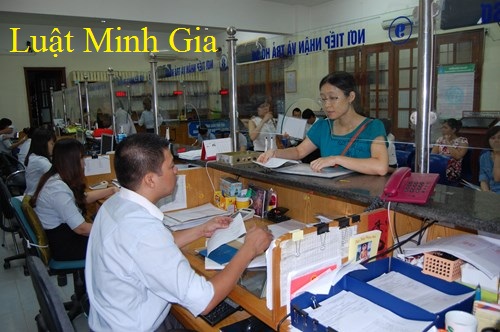Circular No. 132/2015/TT-BTC guiding the financial management for Vietnam Environment Protection Fund
THE MINISTRY OF FINANCE
Circular No. 132/2015/TT-BTC dated August 28, 2015 of the Ministry of Finance guiding the financial management for Vietnam Environment Protection Fund
Pursuant to the Law on Environment Protection dated June 23, 2014;
Pursuant to the Government's Decree No. 215/2013/ND-CP dated December 23, 2013 defining the functions, tasks, entitlements and organizational structure of the Ministry of Finance;
Pursuant to the Prime Minister’s Decision No. 78/2014/QD-TTg dated December 26, 2014 on organization and operation of Vietnam Environment Protection Fund;
At the request of Director of the Financial Department for banks and financial institutions;
The Minister of Finance promulgates the Circular providing guidance on financial management mechanism for Vietnam Environment Protection Fund.
Chapter I
GENERAL PROVISIONS
Article 1. Scope of adjustment
This Circular provides guidance on financial management mechanism for Vietnam Environment Protection Fund organized and operating under the Prime Minister’s Decision No. 78/2014/QD-TTg dated December 26, 2014 on organization and operation of Vietnam Environment Protection Fund (hereinafter referred to as Decision No. 78/2014/QD-TTg).
Article 2. Subject of application
1. Vietnam Environment Protection Fund (hereinafter referred to as the Fund)
2. Relevant agencies, organizations and individuals;
Article 3. Principles of financial management
1. The Fund is the financial institution affiliated to the Ministry of Natural Resources and Environment operating not for profit but guaranteeing charter capital maintenance and self-balance of administrative expenses, enjoying exemption from taxes and remittances to state budget for activities of environmental protection in accordance with regulations on taxation and state budget.
2. The Fund operates in open, transparent and fair way in accordance with laws.
3. The Fund shall be subject to inspection, investigation and auditing over financial activities by state administration agencies on finance and state audit.
Article 4. Responsibility regime
The Management Board, Executive Committee and Director of the Fund shall be responsible to the law and state administration agencies for managing capital and assets of the Fund, ensuring purposeful and effective use of capital, and complying with regulations on financial management, accounting and audit.
Chapter II
REGULATIONS ON CAPITAL SOURCES AND ASSETS
SECTION 1. MANAGEMENT OF CAPITAL SOURCES AND USE OF CAPITAL OF THE FUND
Section 5. Capital sources for operations of the Fund
Capital for operations of the Fund comprises:
1. Charter capital
a) Charter capital of the Fund to 2017 is VND 1,000 billion. Plan for addition of charter capital to the Fund is prescribed in Clause 1, Article 7 of Decision No. 78/2014/QD-TTg;
b) Additional charter capital to the Fund comes from the following sources:
- State budget;
- Development investment Fund;
2. Annual additional capital for operations comes from the following sources:
a) State budget;
b) Compensations for damage caused to environment and biodiversity transferred to state budget as prescribed;
c) Fees for sale and transfer of Certified Emissions Reductions collected from CDM projects implemented in Vietnam;
d) Aids, grants, voluntary contributions, investment trusts from organizations and individuals at home and abroad intended for environmental protection and response to climate change;
dd) Difference from annual receipts and expenses as prescribed in Point a, Clause 1, Article 15 hereof;
e) Other legal capital sources as prescribed;
Article 6. Use of capital
The Fund is used to:
1. Provide preferential loans for environmental protection projects across the country;
2. Support loan interests for environmental protection projects acquiring loans from credit institutions;
3. Sponsor and co-sponsor activities of environmental protection with sources other than expenses from state budget allocated to ministries, sectors and localities for activities of environmental protection;
4. Perform a number of financial policies for investment projects according to Clean Development Mechanism (CDM) including:
a) Organize, monitor, manage and collect fees from sale of Certified Emissions Reductions granted to CDM projects implemented in Vietnam by CDM Executive Board;
b) Support activities of dissemination, propagation and enhancement of awareness about CDM projects; examine and grant approval for documents and materials of CDM projects; manage and monitor CDM projects;
c) Subsidize products from CDM projects;
5. Subsidize electricity price for wind power projects under the Prime Minister’s decision and applicable regulations;
6. Finance activities of coping with climate change as prescribed;
7. Undertake programs, projects and other duties assigned by the Prime Minister and the Minister of Natural Resources and Environment;
8. Invest in fundamental construction and purchase fixed assets serving operations of the Fund;
9. Deposit unemployed capital in commercial banks of high credibility as classified by the State Bank in order to maintain and develop capital to the Fund; The Management Board shall promulgate regulations on management and investment of unemployed capital in commercial banks;
Article 7. Capital adequacy
1. The Fund shall be responsible for executing regulations on guaranteeing capital adequacy for operations including:
a) Make purposeful and effective use of capital;
b) Buy property insurance and other insurances as prescribed;
c) Establish funds for loan loss provision according to the Fund's instructions on operations;
d) Take other measures to guarantee capital adequacy as prescribed;
2. The Funds is forbidden to:
a) Mobilize capital in the form of deposits, issuance of exchange bills, treasury bills, bonds and getting loans from organizations and individuals at home and abroad;
b) Use capital sources for dealing in currency, securities investment, real estate and other illegal business activities;
SECTION 2. ASSET MANAGEMENT
Article 8. Investment in fixed assets
1. Purchase of fixed assets for operations of the Fund is implemented on the principle that the remaining value of total fixed assets does not exceed 10% of real charter capital of the Fund at the time of purchasing.
2. Annually, the Fund must establish and submit the plan for investment in fixed assets to the Management Board for examination and approval. Purchase of fixed assets for operations of the Fund shall be submitted by director of the Fund to the Management Board for decision under the established annual plan.
3. Order and procedures for purchase of fixed assets are prescribed in the laws on management of investment in fixed assets and applicable regulations on enterprises of which 100% charter capital is held by the State. The Fund shall be responsible for buying property insurance as prescribed.
4. The Fund shall calculate depreciation of fixed assets according to applicable regulations on enterprises of which 100% charter capital is held by the State.
Article 9. Inventory, re-valuation, disposal and transfer of assets
1. Inventory of assets
The Fund shall carry out inventorying up assets according to regulations on enterprises of which 100% charter capital is held by the State as prescribed. Responsibility of relevant people for excess or deficit of assets must be identified and compensations must be made as prescribed.
2. Re-assessment of assets
The Fund shall carry out re-assessment of assets according to regulations on enterprises of which 100% charter capital is held by the State. Differences in value from re-assessment of assets shall be prescribed in each particular case.
3. Disposal, transfer of assets
a) The Fund is entitled to dispose and transfer low-quality, degraded, damaged, technologically backward or no longer needed assets to recover capital on the principle of public disclosure, transparency, capital maintenance and compliance with regulations on enterprises of which 100% charter capital is held by the State;
b) Authority to decide disposal, transfer of fixed assets;
- The Management Board shall make decisions on plans for disposal, transfer of fixed assets with the remaining value below 50% of real charter capital publicly announced in the most recent quarter but not in excess of limits of Group B projects or may authorize director of the Fund to make decisions;
- Plans for disposal, transfer of fixed assets greater than level allocated to the Management Board in value shall be decided by the Minister of Natural Resources and Environment.
Article 10. Handling of losses assets
Upon losses on assets, the Fund must determine lost value, causes, responsibility and handle as follows:
1. Determine objective reasons (natural disasters, diseases, conflagration, accidents, and political risks) and subjective reasons;
2. In case of subjective reasons, organizations or individuals causing losses must make compensations as prescribed; The Management Board shall make decisions or authorize director of the Fund to make decisions on level of compensations and take responsibility for its decisions.
3. Any asset that is insured shall be handled according to laws in the area of insurance
4. Value of the asset after losses are compensated for by organizations and individuals that cause the loss and insurance organizations shall be accounted for as expenses in the period.
5. In special cases such as natural disasters or force majeure events that cause serious damage beyond control of the Fund, director of the Fund shall make reports to the Management Board on handling measures for submission to the Minister of Natural Resources and Environment for decision.
Chapter III
REVENUES, EXPENSES AND PERFORMANCE
Article 11. Revenue of the Fund
Revenues are accounts receivable generated in the period, including:
1. Receipts from operations:
a) Loan interests;
b) Service fees from receipt of entrusted loans, donations from organizations and individuals at home and abroad under the entrustment contract;
c) Receipts from other operations;
2. Receipts from financial activities:
a) Deposit interests;
b) Other receipts from financial activities;
3. Other receipts:
a) Receipts from disposal transfer of fixed assets;
b) Compensations in insurance for damaged assets;
c) Bad debts recovered;
d) Other receipts as prescribed;
Article 12. Expenses of the Fund
Expenses of the Fund are expenses generated in the period necessary for operations in compliance with the principle of revenues and expenses with adequate invoices and vouchers according to laws including:
1. Expenses for operations:
a) Expenses for activities of lending and handling entrustment;
b) Expenses for the establishment of loan loss provision fund;
c) Interests from deposits for environmental remediation in mineral extraction and assurance of imported scraps;
d) Expenses for other operations;
2. Expenses for financial activities comprising expenses in connection with activities of making deposits in commercial banks and other expenses;
3. Expenses for officials and staff according to state regulations on enterprises of which 100% charter capital is held by the State.
a) Expenses for salaries, allowances, wages, overtime pay paid to personnel and staff of the Fund as prescribed;
b) Allowances for members of the Management Board, Executive Committee;
c) Deductions for social insurance, medical insurance, trade union expenses, unemployment insurance;
d) Expenses for female employees according to applicable regulations; expenses for personal protective equipment and uniforms; expenses for security guards;
dd) Other expenses for personnel, staff as prescribed;
4. Expenses for management
a) Expenses for fixed asset depreciation, fixed asset rent, property insurance, repair and maintenance of property, rent or purchase of labor kits, assets, equipment and office supplies serving operations of the Fund; compensations for losses to assets as prescribed;
b) Expenses for outside services: electricity, water, telephone, post and telecommunications, audits, legal services; expenses for use of technical documents, patents, technical services; expenses for transport, fire prevention and fighting;
c) Expenses for domestic and overseas business trips according to state regulations on enterprises of which 100% charter capital is held by the State.
d) Expenses for transactions, external relations, conferences, protocols, festivities as prescribed;
dd) Other expenses as prescribed;
5. Other expenses:
a) Expenses for recovery of bad debts;
b) Expenses for collection of financial penalties as prescribed;
c) Expenses for Communist Party and Union related activities according to state regulations;
d) Expenses for disposal, transfer of assets (if any) including remaining value of the disposed, transferred fixed assets;
dd) Other expenses as prescribed;
6. Limits of expenses as prescribed in Clauses 1, 2, 3, 4, 5 of this Article must be in compliance with state regulations on enterprises of which 100% charter capital is held by the State. In case the regulations are not in place, the Fund shall establish limits and make decisions on spending appropriately and effectively, and also take responsibility to the laws. For expenses not as prescribed or in excess of the limits, the Fund must exclude them from its accounting records and clarify accountability of relevant organizations and individuals and make submission to competent authorities for making decisions on compensation plans.
Article 13. Expenses not accounted in the Fund’s expense
1. Expenses in excess as prescribed in Clause 6, Article 12 hereof;
2. Damages subsidized by the State or paid in compensation by insurance companies or a party that has caused damage;
3. Expenses for administrative violations by subjective reasons; expenses for violations of financial regime;
4. Expenses for investment in fundamental construction, purchasing, upgrading and renovating fixed assets;
5. Expenses without adequate invoices and vouchers;
6. Expenses unrelated to operations of the Fund;
7. Expenses sponsored by other sources;
Article 14. Difference between receipts and expenses
1. Difference between receipts and expenses of the Fund are the difference between total revenue and expenditure generated in the fiscal year as prescribed in Articles 11 and 12 hereof.
2. The difference is positive (+) or negative (-) when revenue is greater or lower than expenditure respectively.
Article 15. Difference’s distribution
1. If the difference is positive and after all financial penalties for administrative violations and other compensations (if any) are paid, it (the difference) shall be distributed as follows:
a) 20% shall be added to the Fund’s capital source for implementing subsidies, sponsorships; The Fund shall be responsible for making a separate entry for this capital;
b) 30% shall be added to the Development Investment Fund;
c) Deductions for commendation and welfare funds:
- If the annual action plan approved by the Management Board at the beginning of the year is accomplished, the Fund is allowed to deduct a maximum of three months’ salary from the two funds;
- If the annual action plan approved by the Management Board is not accomplished, the Fund is allowed to deduct a maximum of two months’ salary from the two funds;
d) Remaining value after abovementioned funds are established shall be added to Development Investment Fund.
2. When the difference in the fiscal year is negative, the Fund is allowed to transfer the deficit to the next year and the time for transfer is no more than five years since the year succeeding the year of loss. If the deficit cannot be transferred totally after five years, the Fund shall make written notifications to the Ministry of Natural Resources and Environment for presiding over and cooperating with the Ministry of Finance in making submission to the Prime Minister for consideration and decision.
Article 16. Fund’s use
1. Development Investment Fund is used as an additional source for the Fund’s charter capital.
2. Commendation Fund is used to
a) Give bonus to officials and staff at the end of year or periodically;
b) Give unexpected bonus to individuals or collectives for innovations in technical improvements and business processes that bring efficiency to operations of the Fund;
c) Give bonus to individuals or units outside the Fund for significant contributions to operations and management of the Fund.
The Management Board shall promulgate regulations on commendations for the Fund to implement.
3. Welfare Fund is used to:
a) Finance activities of investment and construction or repair work, serve as an additional capital for the construction of welfare works of the Fund or general welfare works of the Sector;
b) Finance public welfare activities of officials and staff, social welfare;
c) Provide financial assistance for unexpected financial difficulties faced by officials and staff of the Fund including those who are retired or loss of working capacity;
d) Finance other welfare activities;
Use of Welfare Fund is decided by director of the Fund after consulting with the Fund’s Union.
4. Use of the funds above must be in compliance with regulations on financial disclosure, democracy at grass-root levels and state regulations.
Chapter IV
FINANCIAL PLAN, ACCOUNTING REGIME AND FINANCIAL AUDIT
SECTION 1. FINANCIAL PLAN
Article 17. Financial plan
1. Based on annual strategy, orientation and plan for operations approved by the Ministry of Natural Resources and Environment, the Fund shall formulate annual financial plans and make submission to the Management Board for approval.
2. The Fund’s annual financial plan comprises basis issues as prescribed in Appendices 1, 2, 3 enclosed herewith.
3. Process of approving and promulgating annual financial plans:
a) The Fund shall formulate annual financial plans for the next year, make the submission to the Management Board for approval and to the Ministry of Natural Resources and Environment before December 31 annually.
b) Before June 01 annually, the Fund shall submit the next year’s plans for use of capital to the Management Board for approval, to the Ministry of Natural Resources and Environment for compilation and to the Ministry of Finance for submission to competent authorities for consideration and decision.
SECTION 2. ACCOUNTING REGIME AND FINANCIAL AUDIT
Article 18. Accounting regime
1. The Fund shall carry out accounting regime according to regulations on accounting and instructions of the Ministry of Finance.
2. The Fund’s financial year starts January 01 and ends December 31 of calendar year.
Article 19. Financial statement and other reports
1. At the end of accounting period (quarterly or yearly), the Fund must establish and submit explanations and financial statements to the Ministry of Natural Resources and Environment and the Ministry of Finance according to applicable regulations.
2. Quarterly or annual reports:
a) Financial statements: Balance sheet, income statement, cash flow statement, explanations of financial statements, distribution of difference between revenue and expenditure and use of funds, reports on sponsorships and subsidies as prescribed in Appendices 4, 5, 6 enclosed herewith;
b) Other reports;
3. Financial audit
a) Annual financial statements of the Fund must be audited by the State audit agency;
b) In case the State audit agency has no plans for audits, the annual financial statements shall be audited by an independent audit organization according to laws.
4. Chairman of the Management Board, director of the Fund shall be responsible for accuracy and honesty of statements above.
5. Time limit for dispatching reports:
a) Quarterly reports must be dispatched on 25th of the first month of next quarter at the latest;
b) Annual reports must be dispatched on March 30 of the following year at the latest.
6. The Fund shall be responsible for supplying information and reports at the request of functional agencies according to laws.
Article 20. Approval, inspection and disclosure of financial statements
1. Annual financial statements of the Fund must be approved by the Ministry of Natural Resources and Environment. Annual financial statements of the Fund must be dispatched to the Ministry of Finance for monitoring.
2. The Executive Committee shall be responsible for organizing inspection and supervision of compliance with accounting regime by the Fund and making reports on results of inspection and supervision to the Management Board.
3. In case of need, the Fund shall be subject to financial inspection by the Ministry of Natural Resources and Environment including:
a) Regular or irregular inspection of financial statement;
b) Inspection of special subjects as required by the task of financial management;
4. Within 120 days since the end of fiscal year, the Fund must make public disclosure of financial statements according to regulations on accounting.
Chapter V
AGENCY’S RESPONSIBILITIES
Article 21. The Ministry of Finance
1. Perform responsibilities as prescribed in Clause 2, Article 8 of Decision No. 78/2014/QD-TTg.
2. Provide instructions on accounting regime in accordance with scale and characteristics of operations of the Fund.
3. Cooperate with the Ministry of Natural Resources and Environment in inspecting and supervising the compliance with regulations on financial management by the Fund according to laws.
Article 22. The Fund
1. The Fund shall be responsible to the law for management, use and maintenance of capital and assets of the State within management.
2. Comply with regulations on financial management as prescribed hereof and other relevant guiding documents.
3. Make annual reports on demands for use of capital (from budget sources reserved for environment) to the Ministry of Natural Resources and Environment for consideration, compilation and submission to competent authorities for approval;
4. Formulate annual final settlement
5. Be subject to management, inspection and monitoring by the Ministry of Natural Resources and Environment and competent agencies according to applicable regulations.
Chapter VI
IMPLEMENTATION PROVISIONS
Article 23. Transitional provisions
Since the effective date of this Circular, all the fund balance established under the Ministry of Finance’s Circular No. 93/2003/TT-BTC dated October 06, 2003 providing instructions on the exercise of regulations on financial management for the Fund shall be used as additional sources to the charter capital of the Fund.
Article 24. Implementation effect
This Circular takes effect on January 01, 2015 and supersedes the Ministry of Finance’s Circular No. 93/2003/TT-BTC dated October 06, 2008.
For the Minister
The Deputy Minister
Tran Van Hieu








Liên hệ để được hỗ trợ nhanh nhất